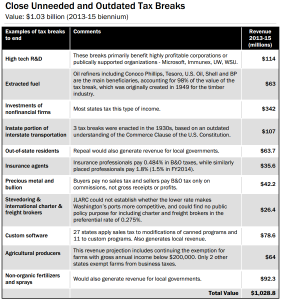Governor’s budget proposal is a step in the right direction – but does not go far enough
by Marilyn Watkins
Our state budget is one of the main ways elected leaders make decisions on our behalf about the future our children and our state will have. Will we continue to underfund education and overcrowd classrooms, or provide adequate resources so kids in every zip code have access to high quality schools? Well, Governor Inslee was on the right track last week – refreshingly so! – when he asserted that education was more important than a handful of special tax breaks, or allowing tax rates on beer and business services to fall. 
But Inslee did not go far enough in his proposal for the 2013-2015 budget that begins this July 1st. Slashing spending on health and education has been the path chosen for 4 years now, limiting opportunity for a generation of children and young adults and undermining the health of vulnerable seniors. Now that Gov. Inslee has pointed us in a better direction, the Senate and House should identify additional new revenue to invest in our common future.
Building a Responsible Budget for Washington State suggests returning the tax rate on service businesses to the level it was 20 years ago, and ending a number of additional tax breaks that funnel money away from our paramount duty: educating our kids to be effective citizens, workers, innovators, and leaders. Together, these sources provide for $2 billion in new revenue beyond Governor Inslee’s $1.2 billion – money that could be invested in expanding quality early learning, fast-tracking K-12 improvements, lowering college tuition, expanding access to higher education, and restoring homecare services to seniors.
The state is under court order to invest substantially more in K-12 education. The McCleary decision will require the state to allocate an additional estimated $3 to $6 billion per biennium to public schools by 2018, in order to meet our constitutionally-mandated obligation to amply fund education for all children. Inslee proposes a $1.3 billion down payment in 2013-15 – but still only funds full-day kindergarten and smaller primary grade class sizes in the highest poverty schools, and continues to deny teachers cost of living raises, which have been withheld since the recession began. Keeping our best educators in the classroom should be a priority, but doing so becomes more difficult as their salaries remain stagnant.
Gov. Inslee does well in proposing the addition of 3,035 more low income preschoolers to the state version of Head Start, but cuts funding that allow working class parents access to high quality daycare for their kids. For higher education, the Governor’s budget holds the line on tuition for technical and community colleges, and limits increases to 3% and 5% at 4-year universities. But after several years of double-digit increases, it’s time to roll back tuition and expand access so our state’s young people have a shot at the high paying careers of the future.
 The additional tax breaks I propose eliminating total $800 million for the biennium and include a number that the nonpartisan Joint Legislative Audit and Review Committee has recommended for legislative scrutiny. For example, the high tech research and development preferences were adopted in the early 1990s when computer software and biotech were beginning to take off. Now they disproportionately benefit not start-ups, but some of the wealthiest corporations on the planet. Microsoft, which reported net US income of $23.6 billion in 2012, claims fully 58% of the high tech sales tax waiver, according to Department of Revenue data. Moreover, a 2012 econometric analysis found little actual impact on job creation.
The additional tax breaks I propose eliminating total $800 million for the biennium and include a number that the nonpartisan Joint Legislative Audit and Review Committee has recommended for legislative scrutiny. For example, the high tech research and development preferences were adopted in the early 1990s when computer software and biotech were beginning to take off. Now they disproportionately benefit not start-ups, but some of the wealthiest corporations on the planet. Microsoft, which reported net US income of $23.6 billion in 2012, claims fully 58% of the high tech sales tax waiver, according to Department of Revenue data. Moreover, a 2012 econometric analysis found little actual impact on job creation.
It’s also time to return the business tax rate on services to the 1990s level. The U.S. economy has shifted from goods-based to service-based, yet Washington continues to rely on the retail sales tax – paid mostly on goods – for fully half the General Fund budget. Meanwhile, the burgeoning service sector – including attorneys, consultants, software engineering, and personal services – contributes relatively little for public services. This disparity between our cutting-edge economy and out-of-touch tax structure is one of the reasons it is such a struggle for the state to adequately fund education.
In 2010, the legislature temporarily raised the Business and Occupation (B&O) tax rate on services from 1.5% to 1.8%. Without legislative action, the rate will revert to 1.5% on July 1, 2013. Over the past 3 years, jobs have grown in business and professional services at over twice the rate of overall job growth in the state. From 1993 to 1998, the service rate ranged between 1.6% and 2.5% depending on the kind of service and year. Inslee proposes keeping the 1.8% rate, for added revenues of $534 million. By going back to that 2.5% rate, Washington could collect another $1.2 billion to adequately fund education.
Of course, in the long run, we have to do more than end lower priority tax breaks and tweak rates. We need a whole new tax structure that reflects the modern economy and that requires the wealthiest – who have benefited the most from civil society – to contribute their fair share. Major tax reform won’t occur before the legislature is scheduled to adjourn on April 28th, but we can still make a major new investment in our kids.
Every child starts kindergarten just once. The students who entered high school in the fall of 2009 after budgets were slashed because of the Great Recession will be graduating (for the most part, we hope) this spring. Every year we dither and postpone means another group of kids with diminished hopes and fewer life chances. Let’s stop talking and start acting.
Originally published at Washington Policy Watch
